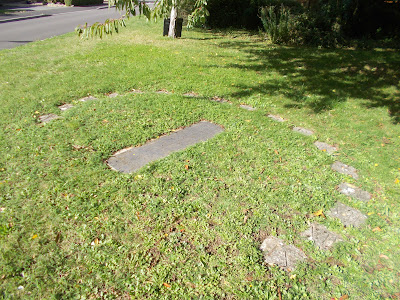A sundial is an instrument used outdoors for determining the hour of the day, when the sun is shining. The shadow of an upright object (known as a gnomon) falls on a flat or curved surface, which is marked with the hours. The earliest known sundials were used by the Egyptians in around 1500 BC. In medieval and early modern Europe the sundial was the most popular way of telling the time.
Sundials can be either altitude dials or direction dials. With altitude dials the time of day is determined by the altitude of the sun. Altitude dials can be sub-divided into plane, cylinder, scaphe and ring. With direction dials, the time is determined by the sun's azimuth (compass direction) or hour angle. Direction dials can be sub-divided into horizontal (including analemmatic), vertical, polar, equinoctial/equatorial (including armillary spheres), azimuthal and multiple/polyhedral.
Piles Mill near Allerford
This double-sided equatorial sundial was given by the Minehead and West Somerset Centre of the National Trust in 1984 to commemorate the 50th anniversary of Richard Dyke Acland's gift of the Holnicote Estate to the National Trust in 1944. It was unveiled by his son Sir John Acland. It is made from Limpley Stoke limestone and was designed by David Brown to look like a millstone and carved by the National Trust's stonemason John Salter.
Piles Mill Sundial
Scratch dial, East Stoke Church
Scratch dials are also known as mass dials. They are medieval (1100-1600) sundials found on the south side of many churches. They are thought to have shown the times of mass and other church services. There would once have been a metal or wooden rod or gnomon in the hole in the centre of the dial, which would have cast a shadow.
Scratch dial, East Stoke Church
Scratch dial, St Mary's Church, East Brent
Scratch dial, St Michael's Church, Creech St Michael
Scratch dial, St Michael's Church, Creech St Michael
Scratch dial, St Andrew's Church, Burnham-on-Sea
Barrington Court
This is a dodecahedron dial with pentagonal faces.
Barrington Court
Barrington Court
Armillary Sphere, Tintinhull Gardens
This is a type of equinoctial/equatorial sundial.
Analemmatic sundial, Peile Drive, Taunton
The inscription on the sundial reads "The light of learning cast its shadow here from 1939-1994. Stand facing your shadow with toes on the date scale." Bishop Fox School was located here until it moved to its present site on Calway Road in September 1994. Analemmatic sundials are a type of horizontal sundial in which the gnomon (in this case a human being) is vertical and hour markings are marked in an elliptical pattern. The position of the gnomon varies, depending on the month of the year.
Analemmatic sundial, Peile Drive, Taunton
Analemmatic sundial on Minehead seafront
This sundial was provided by West Somerset District Council with the support of Minehead Town Council to commemorate the Golden Jubilee of Her Majesty, The Queen in June 2002. The names of the towns in West Somerset (Minehead, Williton, Watchet and Dulverton) are arranged around the centre and further out the names of all the parishes in West Somerset are listed in alphabetical order in a ring.
Close-up view of the centre of the Minehead analemmatic sundial
Scratch dial, East Quantoxhead Church
Vertical sundial, Stapley Mill
Sundial House, Wheddon Cross
Vertical declining sundial on Sundial House at Wheddon Cross
This sundial dates from c1850. It shows the hours from 5aqm to 4pm and the half hours are shown by fleur de lys symbols. The Latin motto shown on it is tempus edax rerum, which means time devours all things.
Lady Smith Memorial Institute/Parish Rooms, Somerton
This vertical sundial was commissioned by Somerton U3A to mark the new millennium and was unveiled on 8th July 2000. It was made by Peter Walker and features a dragon at the centre. It shows the hours from 7am to 5pm in hours and half hours.
Vertical sundial, St George's Church, Ruishton
The Latin motto engraved at the top of the sundial says "concito gradu", which means "with hurried step".

Scaphe sundials, Church of St Peter & St Paul, Bleadon
Vertical sundial on Ilminster Old Grammar School
This sundial is dated 1586. The Latin motto above it says "Sic transeunt dies tui", which means "So passeth your days".
Vertical sundial above the porch of St Augustine's Church, West Monkton
This sundial is dated 1725
Horizontal sundial in the Dunster Village Garden
Horizontal sundial in the Garden of Remembrance at St George's Church, Bicknoller It has the date 9th July 2010 carved on the gnomon.
Horizontal sundial, Victorian shrubbery, Hestercombe Gardens
Horizontal sundial, Marine Cove Gardens, Burnham-on-Sea
This sundial was unveiled in March 2021. It was made by Wells Cathedral stonemasons and replaced an early one, which was damaged beyond repair by vandals.
Vertical dial over the porch door of St Nicholas's Church in BrushfordThis sundial is a memorial to William Wood. It shows the hours from 6am to 6pm, with 30, 15 and 5 minute intervals shown. The motto Memor esto brevis aevi, which means "Bear in mind how short life is" is inscribed on it.
Market Cross, IlchesterThis is made of Ham stone and also features a weather vane and a sundial at the top of a Doric column. The original sundial dated from 1792. This was damaged in a gale in 1990 and was replaced in 1991. The original motto was indecipherable and the current one is tempus orbis.
Holy Trinity Church, Burrington
This vertical sundial has the motto "Life is but a shadow" carved below it. It was apparently a gift from John Addington of Langford Court.
Vertical sundial, St Mary's Church, Cossington
Vertical sundial, St Lawrence's Church, Lydeard St Lawrence
IHTS Wardnes 1653 is written around the gnomon.








































